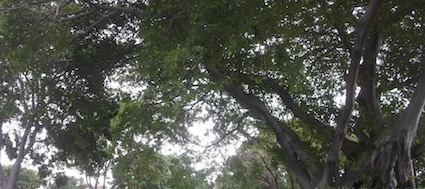Dear Reader, in this age of AI created content, please support with your goodwill someone who works harder to provide the human-made. Sign up at the top of the lefthand column or bottom of this page. You will receive my hand illustrated monthly newsletter RESTORE NATURE and access to the biodiversity garden design course as I write...and nothing else, I respect your time. I am also removing the advertizing as best I can as its become intrusive inappropriate and pays me nothing.
a visual artist and gardener evaluates constructal law
 the patterning of the branching of trees has intrigued artists from leonardo to paul klee
the patterning of the branching of trees has intrigued artists from leonardo to paul kleeI recently stumbled across the constructal law of Adrien Bejan while researching on biomimicry. I read his article co-authored with Sylvie Lorente (Bejan and Lorente, 2010, “The constructal law of design and evolution in nature” Philosophical transactions of the royal society B) and I’ve also read quite a number of the comments of his critics and supporters on blogs and science threads.
The oft cited core statement of constructal theory authored by Bejan is the following:
“ For a finite size flow system to persist in time, to live, it must evolve such that it provides greater and greater access to the currents that flow through it ”

how does bejan apply this constructual law
Bejan applies the constructal law widely to explain river systems, sociology, technological evolution and more. Flows can be anything from potential to thermal energy, to human beings or ideas. Bejan calls his law constructal law or a law of thermodynamics and in this paper, cites the first two laws of thermodynamics and presents their representation as quantifiable formulae.
criticisms of bejan's law
The statement of the constructal law is criticized in blog posts and other writing for being vague, obvious and based on previous knowledge. Supporters on the positive extreme praise the theory as a solution to everything. Its most enthusiastic supporters are sociologists who have found in it a way of explaining apparently complex behaviour.
my own reservations
My problem is that though the first and second law of thermodynamics can be encapsulated in a simple short formula the constructal law is is not (not in his paper anyway, or in any online document I found during my searches) encapsulated in any single formula.
So in the paper in question this purported law of thermodynamics is formulated verbally, and not numerically, as the other thermodynamics laws are, as a single equation.
I ask myself if this is because it is not a thermodynamic law, actually, in the sense the others are, and calling it a thermodynamic law is a very bad fit with what it really is. Does it venture on territory that cannot be quantified in the same way with a single formulation, or were the thermodynamic laws quantified long after their authorship, and we should wait and see what history gives.
bejan's quantitative embodiments of the law
Bejan does produce many quantifying formulae that he claims as directly deriving for the law, and many of these were created a long time ago to describe various natural phenomenae, such as scaling. But he does not explain, at least not in this paper, how these relate to the constructal law numerically. Scaling describes the proportion of branches of a reticulated system. The first order and second order branches and higher order may have a relationship of length and thickness, or show scaling. Such relationships were described with diverse formulae by Leonard da Vinci (the thickness of tree branches) and others who described river systems.
an artist's qualified conclusion
The theory seems to be doing useful work filling in what was previously as Bejan describes it “a black box”. The input and output of energy systems were quantified, but the means and its appearance not. Perhaps the this law is a work in progress and clearer formulations are to be found in the right books, or will be found in later authorship, in his intellectual descendants.

It’s a difficult area to describe, which is why patterning in nature or in flow systems stood unexamined, except here and there, for so long. Its obvious to the eye that there is a regular dynamic at work, in tree branching, river branching and other systems. Previously these effects were attributed to randomness and chance, and their regularity must have been embarrassing.
why the law is loved outside engineering
The creation of the Bejan's law of thermodynamics lags hundreds of years behind the other thermodynamic laws. There have been earlier attempts to explain the visible effects of flow systems with fractals which branch based on the simplest of formulae. The constructal law resonates with many disciplines and it embodies very recent insights in some ways. I’m persuaded as an artist there is something in there. It’s a sensibility brought on by decades of drawing trees and plants. Perhaps some engineers wouldn't feel the inherent sense of explaining visual effects mathematically, as they have not experienced the same level of engagement with natural patterning as an artist. Hence Bejan’s observations seem fruit-cakey to them. Bejan was an art student and national basketball player in Romania before he went to MIT. Both sport and visual art engage another kind of intelligence than school mathematics. To an artist it is obvious there is very regular pattern in nature. Hence it is not surprising that Leonardo da Vinci came up with one of the earliest formulae for tree branching, which is one of the legs on which Bejan bases constructal law. This visual awareness of geometry in nature is brought by visual training and the conviction cannot really be explained in words to the person who has not been thus sensitized, it is inchoate knowledge. The scorn poured on Bejan is evidence of our knowledge systems belonging in segregated fields. One critic said that such pseudo science would prevail until more humanities people did maths. I also think that the blind spots and lack of curiosity about certain aspects of the observable world will prevail until mathematicians and engineers do some art. Maybe Bejan is a pseudo, I don’t have enough maths to assess that, but MIT has him on their lecturing staff, and I laud his attempt to explain the observable phenomenon of
natural patterning that is ignored by the large majority of ‘scientists’. There are some areas in which we will not move forward without Renaissance minds, and people who break free of compartmentalized knowledge, and the separation of the prescribed areas of specialization of the disciplines. As I’ve learned from studying statistics, chemistry, linguistics, history, art and archaeology, the boundaries of so many intellectual categories are constructed and not real, and they all melt away when examined closely.
home page for more green inspirations
Restore Nature Newsletter
I've been writing for four years now and I would love to hear from you
Please let me know if you have any questions, comments or stories to share on gardening, permaculture, regenerative agriculture, food forests, natural gardening, do nothing gardening, observations about pests and diseases, foraging, dealing with and using weeds constructively, composting and going offgrid.
SEARCH
Order the Kindle E-book for the SPECIAL PRICE of only
Prices valid till 30.09.2023
Recent Articles
-
garden for life is a blog about saving the earth one garden at a time
Apr 18, 25 01:18 PM
The garden for life blog has short articles on gardening for biodiversity with native plants and regenerating soil for climate amelioration and nutritious food -
Cape Flats Sand Fynbos, Cape Town's most endangered native vegetation!
Apr 18, 25 10:36 AM
Cape Flats Sand Fynbos, a vegetation type found in the super diverse Cape Fynbos region is threatened by Cape Town's urban development and invasive alien plants -
Geography Research Task
Jan 31, 25 11:37 PM
To whom it may concern My name is Tanyaradzwa Madziwa and I am a matric student at Springfield Convent School. As part of our geography syllabus for this
"How to start a profitable worm business on a shoestring budget
Order a printed copy from "Amazon" at the SPECIAL PRICE of only
or a digital version from the "Kindle" store at the SPECIAL PRICE of only
Prices valid till 30.09.2023








